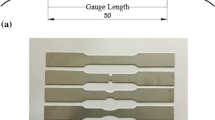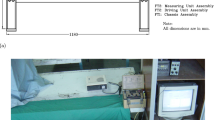Abstract
A single edge cracked geometry with clamped ends is well suited for fracture toughness and fatigue crack growth testing of composites and thin materials. Analysis of fiber bridging phenomenon in the composites and determination of stress intensity factors due to non-uniform stress distributions such as residual and thermal stresses generally require the use of a weight function. This paper describes the development and verification of a weight function for the single edge cracked geometry with clamped ends. Finite element analyses were conducted to determine the stress intensity factors (K) and crack opening displacements (COD) due to different types of stress distributions. The weight function was developed using the K and COD solution for a constant stress distribution. K and COD predicted using this weight function correlated well with the finite element results for non-uniform crack surface stress distributions.
Similar content being viewed by others
References
M.L. Gambone, Fatigue and Fracture of Titanium Aluminides, WL-TR-89–4145, Materials Laboratory, Wright-Patterson AFB, Ohio 45433–6533, USA (1990).
R. John, S.G. Kaldon and N.E. Ashbaugh, Applicability of Fiber Bridging Models to Describe Crack Growth in Unidirectional Titanium Matrix Composites, UDR-TR-94–53, University of Dayton Research Institute, Dayton, Ohio, USA (1994).
D. Blatt, R. John and D. Coker, Engineering Fracture Mechanics 47 (1994) 521–532.
V.A. Kramb, R. John and N.E. Ashbaugh, in Ninth Annual Technical Conference, American Society for Composites, Technomic Publishing Co., Inc., Lancaster, Pennsylvania 17604, USA (1994).
D.O. Harris, Journal of Basic Engineering 89 (1969) 49–54.
O.L. Bowie, C.L. Freese and D.M. Neal, Journal of Applied Mechanics 40 (1973) 767–772.
N. Marchand, D.M. Parks and R.M. Pelloux, International Journal of Fracture 31 (1986) 53–65.
J. Ahmad, V. Papaspyropoulos and A.T. Hopper, Engineering Fracture Mechanics 38 (1991) 283–294.
T.X. Dao and S.R. Mettu, Analysis of an Edge-Cracked Specimen Subjected to Rotationally-Constrained End Displacement, NASA JSC 32171 (1991).
H.F. Bueckner, Z. Angew. Math. Mech. 50 (1970) 529–546.
J.R Rice, International Journal of Solids and Structures 8 (1972) 751–758.
A.C. Kaya and F. Erdogan, International Journal of Fracture 16 (1980) 171–190.
H.J. Petroski and J.D. Achenbach, Engineering Fracture Mechanics 10 (1978) 257–266.
R.P. Ojdrovic and H.J. Petroski, Engineering Fracture Mechanics 39 (1991) 105–111.
T. Fett, International Journal of Fracture 43 (1990) 195–211.
G.S. Wang and A.F. Blom, Engineering Fracture Mechanics 44 (1993) 307–326.
X.-R. Wu and A.J. Carlsson, Weight Functions and Stress Intensity Factor Solutions, Pergamon Press, Inc., Elmsford, New York, USA (1991).
G. Shen and G. Glinka, Theoretical and Applied Fracture Mechanics 15 (1991) 237–245.
T. Fett, Engineering Fracture Mechanics 42 (1992) 435–444.
R. John and S.G. Kaldon, Engineering Fracture Mechanics, submitted for publication (1995)
ADINA-A Finite Element Program for Automatic Dynamic Incremental Nonlinear Analysis, Report ARD 89-1, ADINA R & D, Inc., Watertown, Massachussets, USA (1989).
R.S. Barsoum, International Journal of Numerical Methods in Engineering 10 (1976) 25–37.
H. Tada, P.C. Paris, and G.R. Irwin, The Stress Analysis of Cracks Handbook, Del Research Corporation, St. Louis, Missouri, USA (1985).
A.R. Ingraffea and C. Manu, International Journal of Numerical Methods in Engineering 15 (1980) 1427–1445.
N.A.B. Yehia and M.S. Shephard, International Journal of Numerical Methods in Engineering 21 (1985) 1911–1924.
T. Fett, Engineering Fracture Mechanics 46 (1993) 655–662.
M. Abramowitz and I.A. Stegun, Handbook of Mathematical Functions, Dover Publications Inc., New York, New York, USA (1972).
Author information
Authors and Affiliations
Rights and permissions
About this article
Cite this article
John, R., Kaldon, S.G., Johnson, D.A. et al. Weight function for a single edge cracked geometry with clamped ends. Int J Fract 72, 145–158 (1995). https://doi.org/10.1007/BF00042825
Received:
Accepted:
Published:
Issue Date:
DOI: https://doi.org/10.1007/BF00042825




